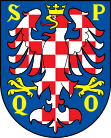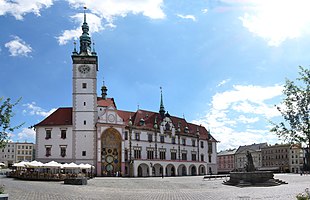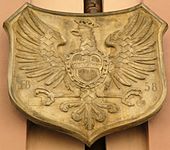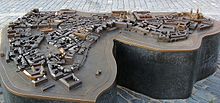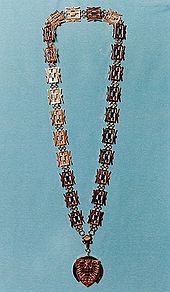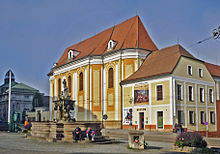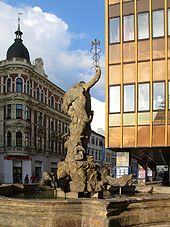Olomouc
| Olomouc | ||||
|---|---|---|---|---|
|
||||
| basic data | ||||
| State : |
|
|||
| Historical part of the country : | Moravia | |||
| region : | Olomoucky kraj | |||
| District : | Olomouc | |||
| Area : | 10333 ha | |||
| Geographical location : | 49° 36′ N , 17° 16′ E | |||
| Height: | 219 m nm | |||
| residents : | 100,514 (1 Jan 2021) | |||
| Zip code : | 771 00 – 779 00 | |||
| License plate : | M (old: OL, OC, OM) | |||
| structure | ||||
| Status: | Statutory City | |||
| Districts: | 26 | |||
| administration | ||||
| Lord Mayor : | Antonín Staněk (ČSSD) (Status: 2014) | |||
| Address: | Horní namesti 1 771 27 Olomouc |
|||
| Municipality number: | 500496 | |||
| site : | www.olomouc.eu | |||
Olomouc ( Czech Olomouc [ ˈɔlɔmɔuʦ ]) is the sixth largest city in the Czech Republic and the administrative center of the Olomouc Region ( Olomoucký kraj ). The city is the seat of an archdiocese , the second oldest Czech university and one of the two Czech supreme courts. Until the 17th century it was the historical center of Moravia and today it is a commercial, cultural and administrative center.
geography
position
Olomouc is located in the eastern part of the Czech Republic, in Moravia, in the Morava floodplain at the confluence of the Feistritz . The city is located in a plain open to the north-west and south-east, surrounded by higher geomorphological formations from the west and especially from the east. The city center is at an altitude of 219 m above sea level. M
climate
The annual average temperature is 8.7 °C, the average annual precipitation around 570 mm. The average sunshine duration is 1616.7 hours per year.
city outline
The city of Olomouc consists of the districts and cadastral districts:
- Bělidla (pale)
- Černovír
- Chomoutov (Komotau)
- Chvalkovice
- Droždín (droshdein)
- Hejčín (hat ticket)
- Hodolany (Hodolein)
- Holice
- Klášterní Hradisko (Radisch Monastery, with Hradisko Monastery )
- Lazce
- Lošov
- Nedvězí (Nedweiß)
- Nemilany (Nimlau)
- Neředín (Neretein)
- Nová Ulice (Neugasse)
- Nové Sady
- Nový Svět (Salzergut)
- Olomouc
- Pavlovicky (Paulowitz)
- Povel
- Radíkov
- Řepčín (Repschein)
- Slavonín (Schnobolin)
- Svatý Kopeček (Heiligenberg, formerly Mariendorf)
- Topolany
- Týneček (Klein Teinitz)
Basic settlement units 17. listopadu, Balcárkova, Bělidla I Bělidla II, Bystrovanská, Černá cesta, Černovír, Českobratrská, Droždín, Družební, Fakultní nemocnice, Hádky, Hejčín, Heyrovského, nádraží Hlavní, Hodolany, Hodolany-průmyslový obvod, Holice, Holická, Husova, Chomoutov, Chválkovice, Chválkovice-jih, Jezírka, Jihoslovanská, Karafiátova, Klášterní Hradisko, Kosmonautu, Kpt , Nemilany, Neředín, Neředín-u pevnůstky, Norská, Nové Sady-jih, Nové Sady-sever, Novosadská, Nový Svět, Olomouc-historické jádro, Ondřejova, Ovesniska, Pavlovičky, Pionýrská, Pod koupalištěm, Pod lipami, Povel-jih, Pražská východ, pražská-západ, Průmyslová zóna Hodolany, Přichystalova, Radíkov, Řepčín, Sady Flora, Schweitzerova, Slavonín, Sobieského, Stadiony, Stiborova, Stupkova, Svatý Kopeček, Šantova, Šibeník, Štítného, Tererovo náměstí, Topolany, Tovární, Trávníky , Týneček, U hvězdárny, U Chválkovic, U rybářských stavů, U rybníka, U solných mlýnů and Varšavské náměstí.
Surname
In the 12th century, Olomuc and Olmuc were the first surviving forms of names. In the 15th century an alleged first form Juliomontium ( Juliusberg ) was suspected, after Julius Caesar as the alleged founder. The original meaning is unclear. In Czech, Olomouc means 'bare mountain' (Old Czech holy 'bare' and mauc 'mountain'). The city's name is in the Moravian -Hanak dialect, a subgroup of the Central Moravian dialects of Czech, Olomóc or Holomóc , in German Olmütz , in Polish Ołomuniec , and in Latin Eburum or Olomucium .
coat of arms
Description: In blue, a gold-crowned red and white chess eagle with gold armor ( Moravian eagle ) accompanied by the four gold majuscules S, P, Q, O in the four corners. The letters stand for Senatus populusque Olomucensis ( Latin for "Senate and People of Olmütz", analogous to SPQR ).
The coat of arms was decorated in 1758 with the Austrian shield and the initials "FMT" as a central shield . The occasion was the award of this part of the coat of arms by Maria Theresa in recognition of the steadfastness of Olmütz Fortress against Prussian troops under King Friedrich II. The initials stood for Emperor Franz I and the Empress. A chain was also placed around the shield as a sign of the city's fortifications. These crest improvements were removed in 1934.
story
beginnings
At the end of the 2nd century there was a Roman army camp here, the northernmost known one in Central Europe. Until the 5th century there was a Germanic settlement.
In the late 7th century, the first Slavic settlement arose in what is now the district of Povel. Around 830 it was destroyed. A new castle was built on Petersberg (Předhrad), which by its size was probably one of the most important castles in the Moravian Empire. In the 9th century three churches were built.
Přemyslid state
Olomouc was first mentioned in writing in 1017, when Moravia became part of the Czech Přemyslid state . In 1055 it was the seat of a separate principality. In 1063 the diocese of Olomouc was founded by Vratislav II . Around 1070 a new castle was built. In 1077 the Hradisko monastery was founded. In 1126 Heinrich Zdik became bishop.
At the beginning of the 13th century the last Olomouc prince died, Moravia was united and placed under a margrave from the Přemyslid family. Olomouc was first mentioned as a royal town in 1248 . 1306 King Wenzel III. during a campaign to Poland in Olmütz and was murdered here, whereby the Přemyslid dynasty in the male line died out . The city developed very quickly economically and became the capital of Moravia .
In the Hussite wars , Olomouc was an integral part of the Catholic side. The Olomouc Charterhouse was founded in 1443 as a successor to the Dolein Charterhouse, which had perished in the Hussite Wars . It existed until it was abolished in 1782. In the 16th century, numerous Renaissance -style palaces were built . In 1566 the Jesuits came to Olomouc. They founded a school, which became a university in 1573. In 1588 the bishop was promoted to imperial prince .
17th and 18th centuries
During the Thirty Years' War , the city was taken by the Swedes in 1642 and occupied for eight years. After the Thirty Years' War, the largely destroyed and depopulated city lost its status as the Moravian capital and ceded it to Brno . Since a lot of damage had been caused by fires, a detailed "Fire Extinguishing Ordinance" was issued in 1711, which also discussed a number of preventive measures.
On December 26, 1741, the city was taken by the Prussians in the First Silesian War . After this event, the fortifications were extensively expanded. The new fortifications withstood a second siege by the Prussians in 1758. In 1777 the diocese was raised to an archbishopric.
From 1794 to 1797 the prominent French-American soldier and politician Marquis Lafayette was interned in Olomouc as a political prisoner of the Danube Monarchy after being captured by the anti-French coalition in Flanders in 1792 and then imprisoned by Prussia for the time being .
19th century
In 1841 the city received a railway connection. In mid-1845 the railway from Olomouc to Prague ( kk Northern State Railway ) was put into operation ( Olomouc - Trübau , Trübau - Prague ). In 1848, the archbishop's palace housed the imperial court who had fled here because of the revolution in Vienna . On December 2, 1848, Emperor Ferdinand I transferred the government to eighteen-year-old Franz Joseph I. On November 29, 1850, the German Confederation was restored in Olomouc under Austrian leadership by the Olomouc Punctuation (also called the "Olomouc Treaty") between Prussia, Austria and Russia . In the years 1850 to 1866 the fortifications were expanded again. In 1886 the fortress status was abolished and Olmütz received a city statute as the royal capital. In 1899 the first tram ran in the city. At the end of the 19th century, Olmütz had six Catholic churches, a Protestant church, an Israelite temple , a German and a Czech grammar school, a junior high school, a number of other educational institutions and was an industrial location and the seat of a district authority and a district court.
20th century
After the collapse of the Austrian Empire in 1918 and the founding of Czechoslovakia , the Czech townsfolk became the majority, which was mainly due to the influx of Czechs, the departure of Germans, but also the incorporation of surrounding communities with a partly Czech majority, such as the two towns of Hodolein ( Hodolany ) and Neugasse ( Nová ulice ) and eleven other communities (Bělidla, Černovír, Hejčín, Chválkovice, Lazce, Nové Sady, Nový Svět, Neředín, Pavlovičky, Povel and Řepčín) in 1919. In 1921, 57,206 inhabitants lived in Olomouc.
On March 15, 1939, the city, like the other areas of the Protectorate of Bohemia and Moravia established by the German Reich on the same day, was occupied by the Wehrmacht . In 1939 the Olomouc University was closed by the German occupation forces. Only in 1946 could it be restored under the name Palacký University in Olomouc .
The German-speaking population was expelled from Olmütz in 1945/1946 . Their assets were confiscated by Beneš Decree 108 , the assets of the Evangelical Church were liquidated by Beneš Decree 131 , and the Catholic Churches were expropriated .
In the 1970s and 1980s, several prefabricated housing estates were built on the outskirts .
The entire old town has been protected as a monument reserve since 1971. The flood in 1997 hit the city hard, about a third of the city area was flooded. In 2000, the Trinity Column was included in the UNESCO World Heritage List . After the administrative reform of 2000, the previous district seat became its administrative seat with the establishment of the Olomouc region.
Jews in Olomouc
The first Jews settled in Olomouc as early as 906. From 1060 they had to live in a ghetto and wear a yellow badge. In 1454 all Jews from Olomouc were expelled. This law was in effect until 1848. Six Jews were recorded in the 1857 census.
In 1865 a Jewish religious association was founded in Olmütz, from which the independent Jewish community Olmütz emerged in 1892, whose first rabbi was Berthold Oppenheim . The Olomouc Synagogue was built in 1895-1897. On the night of March 15th/16th, 1939, after the country was occupied by the Wehrmacht, the synagogue burned down as a result of arson. At the same time, around 800 Jews were arrested and later deported to the Dachau concentration camp . Some pews of the synagogue were removed, served for a long time as pews in a village church near Prostějov and were finally placed in the renovated synagogue in Krnov in 2004 . Some of them are now in the Loštice synagogue and commemorate the Jewish citizens who were murdered in the concentration camps. The honorary seat is dedicated to Berthold Oppenheim, the rabbi of Olomouc and Loštice.
During the Nazi era , 3,489 people were deported to the Theresienstadt ghetto in five transports, on June 26 and 30, 1942, July 4, 1942 and March 7, 1945 . Only 285 Jews from the town's population survived. This put an end to Jewish life in Olomouc for a long time. Only since 1989 has there been a revival of Jewish religious life in the city, and in 1991 an independent Jewish community in Olomouc was founded, also responsible for Šumperk , Jeseník , Bruntál and Přerov .
In 2011 the first stumbling blocks were laid in Olomouc by Gunter Demnig . They serve to commemorate the murdered victims of National Socialist rule in the city. Along with Prague and Brno, Olomouc is one of the cities with the most stumbling blocks in the Czech Republic: at the end of 2017 there were 213 stumbling blocks and one stumbling block in Olomouc . In recent years, the Olomouc Jewish community, as the initiator, has been very actively involved in the laying of the stumbling blocks - by autumn 2017 it was responsible for four layings.
demographics
With 100,233 inhabitants, the city of Olomouc is the sixth largest city in the Czech Republic.
| year | resident | Remarks |
|---|---|---|
| 1060 | 10,300 | |
| 1139 | 13,460 | |
| 1237 | 16,300 | with the suburbs |
| 1415 | 29,000 | under King Wenceslaus IV , with the suburbs |
| 1616 | 30,633 | after the plague claimed 4,000 victims in 1599 |
| 1622 | about 14,000 | (not stated whether with or without suburbs), in the first phase of the Thirty Years' War when in 1621 under the imperial general Bucquoy 3,000 non-Catholics had to leave the city |
| 1638 | 30,000 | |
| 1650 | 1,675 | after the Swedish rule (1642-1650) in the Thirty Years' War, after the departure of the Swedes |
| 1715 | 1,500 | |
| 1834 | 12.207 | excluding the garrison (approx. 5,700 men), mostly German Catholics, including 104 Protestants |
| 1857 | 8,349 | without the garrison, of which 8,313 Catholics, 27 Protestants, three Reformed and six Israelites (an additional 6,888 foreigners), according to other sources 13,997 inhabitants |
| 1900 | 21,707 | with the garrison (3,632 men), including 13,982 Germans and 6,798 Czechs (1,676 Jews, 7.7%) |
| 1910 | 22,245 | of which: 2,959 soldiers, 6,746 Czech civilians and 12,156 German civilians (1,633 Jews); by religion: 20,061 Catholic, 423 Protestant, 1,679 Israelite |
| 1919 | 23,622 | of which: 9,772 Czechs and 8,019 Germans (1,010 Jews) |
| 1920 | 57.206 |
| year | 1947 | 1970 | 1979 | 1985 | 1995 | 2000 | 2005 | 2006 | 2007 | 2008 | 2009 | 2010 |
|---|---|---|---|---|---|---|---|---|---|---|---|---|
| resident | 58,000 | 79,407 | 79,407 | 105,513 | 104,845 | 102,702 | 100,381 | 100 168 | 100,373 | 100,373 | 100,362 | 100,233 |
politics
city leaders
|
|
town twinning
Olomouc has twinning agreements with the following cities:
-
 Antony , France
Antony , France -
 Subotica , Serbia
Subotica , Serbia -
 Lucerne , Switzerland
Lucerne , Switzerland -
 Nordlingen , Germany
Nordlingen , Germany -
 Owensboro , United States
Owensboro , United States -
 Pecs , Hungary
Pecs , Hungary -
 Tampere , Finland
Tampere , Finland -
 Veenendaal , Netherlands
Veenendaal , Netherlands
Economy and Infrastructure
Along with Ostrava , Olomouc is the most important economic and transport center in North Moravia.
traffic
Transportation
Inner-city traffic is ensured by five tram lines and 23 bus lines (as of 2011).
railroad
Olomouc Main Train Station is on the main Prague – Česká Třebová – Olomouc – Ostrava / Žilina – Košice line . Other routes lead north to Šumperk and Krnov and west to Senice na Hané . Southbound routes lead to Brno and via Otrokovice (/ Zlín ) to Břeclav and on to Vienna .
flight connection
The nearest airports for long-distance travelers are Prague (three hours by car), Vienna (three hours) and Bratislava (two hours). Closer are the smaller airports Ostrava (1 hour, 45 minutes) and Brno (1 hour).
The public international airport Olomouc-Neředín ( IATA airport code OLO, ICAO code LKOL) is located 3.8 kilometers west of the city center in the district of Neředín. The airfield operates under visual flight conditions only (daytime) and has two asphalt runways for microlight aircraft, 520 and 560 meters long and 30 meters wide, and two grass runways, 760 meters long and 30 meters wide. The air rescue service of the region is stationed at the airfield.
healthcare
The largest facility is the University Hospital ( Fakultní nemocnice Olomouc ) with 1433 beds and 50 departments and clinics (as of 2006). From 1992 to 2004, the clinic was extensively expanded and modernized and is currently one of the most modern hospitals in the Czech Republic. The Olomouc Military Hospital ( Vojenská nemocnice Olomouc ) is the oldest military hospital in the Czech Republic. It was founded in 1748 and since 1802 has been based in the Hradisko Monastery , which is protected as a national cultural monument . There are two more private polyclinics in the town .
Local Businesses
The food industry and mechanical engineering belong to the traditional economic sectors settled in Olomouc. by the OLMA dairy founded in 1970, the chocolate manufacturer ZORA founded in 1899 (today part of Nestlé), the pump technology manufacturers ISH and Sigma (today in Lutín near Olomouc), the Moravské železárny steel works, the salt processor Solné mlýny Olomouc or the chemical and pharmaceutical company founded in 1934 FARMAK.
education
The Palacký University with 21,277 (WS 2007) students is located in Olomouc. The university consists of 8 faculties and a university hospital. It was originally founded as a Jesuit college in 1573 and is the second oldest university in the Czech Republic.
Archdiocese
The diocese was first mentioned in 1063. It was under the archbishopric of Prague until the 18th century . In 1777 Olomouc was raised to the archdiocese. At the same time, the Bishopric of Brno was established as a suffragan of the Archdiocese of Olomouc. Today the Archdiocese includes the region of North and Central Moravia. Archbishop and Metropolitan is Jan Graubner .
Culture
Museums
- Art Museum Olomouc with three sub-museums:
- Archdiocesan Museum in Olomouc in the former house of canons of the Cathedral Chapter and in the Romanesque Zdik Palace of the former Olomouc Castle (Olomoucký hrad) on Cathedral Hill, founded in 2006
- Archdiocesan Museum in the Archbishop's Palace in Kremsier
- Museum of Modern Art Olomouc in the former City Hospital of the Holy Spirit
- Olomouc Fortress Museum, founded in 2007, serves to rebuild and revitalize the listed areas of the Olomouc Fortress
- Folklore Museum (regional museum, founded 1883) in the building of the Clarisse Monastery, which was dissolved in 1782; shows exhibitions on geology, mineralogy, zoology, the prehistory of the region and the history and development of clocks
- Automobile Museum (Oldtimer Museum) Olomouc
- Aeronautics Museum Olomouc-Neředín (closed)
theatre
- Moravian Theater on Horní náměstí, Gustav Mahler was Kapellmeister here from January to March 1883
- Moravian Philharmonic Orchestra in the redoubt on the Oberring
- Music Theater Olomouc
- Konvikt Theater
- Tramtarie Theater
Culinary specialties
The famous Olomouc Quargel , a sour milk cheese with a strong smell, comes from here.
Attractions
The historic city center was declared a municipal monument reserve in 1971.
In addition to numerous town houses, the house facades and historical portals are objects that are particularly worth seeing within the cityscape of Olomouc. These are on the Upper Ring (Horní náměstí).
- the town hall with astronomical clock, Gothic building core from the 14th century, with 78 m high tower and
- the Trinity Column (plague column), baroque building, 35 m high with a chapel, built between 1716 and 1754, protected as a UNESCO World Heritage Site since 2000 .
Another plague column, the Mariensäule, is located on the Niederring.
Olomouc Castle
- Romanesque Bishop's Palace or Zdik's Palace (Zdíkův palác), now Archdiocesan Museum, built under Bishop Heinrich Zdik on today's Wenceslas Square (Václavské náměstí)
- Former canon house of the cathedral chapter, Mozart lived here from October 28 to December 23, 1767 and wrote his 6th symphony, now Olomouc Archdiocesan Museum
Olomouc Fortress
The Olomouc fortifications include e.g.
- Theresientor
- Crown fortress and numerous forts in the suburbs, e.g. B. Fort XXII. (Lazecká) in Olomouc-Chernovir (Černovír) and Fort II. in Olomouc-Radikau (Radíkov)
- Theresian Armory (today University Library)
Fountain
- Hercules Fountain (Baroque fountain from 1687) on the Upper Square (Horní náměstí)
- Caesar fountain (baroque fountain by Wenzel Render , 1725) on the upper ring
- Arion Fountain by Ivan Theimer (2002) on the upper ring
- Neptune Fountain (baroque fountain by Michael Mandik, 1683) on Dolní náměstí
- Jupiter fountain (baroque fountain by Wenzel Render, 1707) on the Niederring
- Triton Fountain (Baroque fountain by Wenzel Render, 1709) on Republic Square (Náměstí republiky)
- Dolphin Fountain (Baroque fountain by Philipp Sattler , 1725/2005), Sokol Street (Sokolská)
- Mercury Fountain (Baroque fountain by Wenzel Render and Philipp Sattler, 1727), 8 May Street (8. Květná)
- Sarkander Fountain (“The Source of Living Water of St. Jan Sarkander ”) next to St. Sarkander Chapel
churches, chapels and monasteries
- Wenceslas Cathedral (Katedrála sv. Václava), built from 1107 to 1131 as a Romanesque basilica, rebuilt in the 14th century in a Gothic style and in the 19th century in a Neo-Gothic style, King Wenceslaus III is here. buried
- St. Mauritius Church (Kostel sv. Mořice), also called Moritzkirche or Mauritzkirche , late Gothic building from the 15th century, the organ of the Moritzkirche is the largest organ in the Czech Republic
- Church of the Immaculate Conception of the Virgin Mary – Dominican Church (Dominikánský kostel)
- Maria Schnee Church – Jesuit Church (Kostel Panny Marie Sněžné)
- Church of St. Catherine of Alexandria (Kostel sv. Kateřiny)
- Archangel Michael Church (Kostel sv. Michaela) (1676 to 1703) by Giovanni Pietro Tencalla and Baldassare Fontana
- Red Church , built in 1902, today it serves as a library
- Church of the Annunciation – Capuchin Church (Kostel Zvěstování Panny Marie)
- Cyril and Methodius Church (Kostel sv. Cyrila a Metoděje) (1929)
- Orthodox Church (Kostel sv. Gorazda) (1939)
- Basilica minor "Visitation of the Virgin Mary" on the Heiligenberg near Olomouc (Svatý Kopeček)
- St. Sarkander Chapel
- St. Anne's Chapel on Cathedral Hill, now a Greek Catholic Church, next to Wenceslas Cathedral
- St. Barbara's Chapel on Cathedral Hill, now part of the Archdiocesan Museum
- Hradisch Monastery (Klášter Hradisko) , built in the 17th and 18th centuries by GP Tencallo and D. Martinelli
- former Dominican monastery
- Former Clarisse monastery, closed in 1782, now regional museum
Palaces, villas and town houses
- Archbishop's Palace (Arcibiskupský palác)
- Romanesque Bishop's Palace or Zdik Palace
- Nobleman's Palace (Edelmannův palác) on the Upper Square (Horní náměstí)
- Petrasch Palace (Petrášův palác) on the Upper Square
- Salm Palace (Salmův palác) on the Upper Square
- Dietrichstein Palace (Ditrichštejnský palác) on the Upper Square
- Hauenschild Palace (Hauenschildův palác), Renaissance building on Dolní náměstí, where Wolfgang Amadeus Mozart lived in 1767
- Jesuit College on Republic Square (Náměstí republiky)
- Zierotin Palace (Žerotínský palác)
- Podstatzky von Prusinowitz Palace (Palác Podstatských z Prusínovic)
- The Golden Deer Town Hall
- Dům U rudého vola tenement house, now a gallery
- Villa Hamburger ( historicism , 1895)
- Villa Primavesi ( Secession style , 1906)
parks
- Čech Park (Čechovy sady)
- Smetana Park (Smetanovy sady) (opened in 1866 by Emperor Franz Joseph I ), formerly Rudolf Avenue
- Bezruč Park (Bezručovy sady) (1898)
- Botanical Garden (Botanické zahrady) with Rosarium (1970)
- Zoo (Zoologická zahrada Olomouc) on Svatý Kopeček
Sports
The successful football club SK Sigma Olomouc and the ice hockey club HC Olomouc are based in Olomouc .
The Mattoni Olomouc Half Marathon is held annually in June . The run is classified as a gold race by the International Athletics Federation. The number of participants is over 4300 runners (2020).
personalities
Well-known personalities of the city are listed in the list of personalities of the city of Olomouc .
trivia
- The cabaret artist Fritz Grünbaum wrote the song The Little Wolf from Olmütz (first lines of the refrain: "Do you know the little wolf from Olmütz / with the breeches and the green woolen hat?"), Which was set to music by Peter Kreuder . A well-known recording was made in 1928 with Curt Bois and the Peter Kreuder Orchestra.
- In 1961, the writer Peter Härtling wrote the poem Olmütz 1942–1945 , in which he vividly describes childhood memories of Olmütz: among other things, the “Haube” from the Bischofsberg, a meeting of the Hitler Youth on the Ring (“a black bloodletting gathers a thousand haters” ), the apartment in the Wassergasse (today Mlýnská ul.; the line “the river solidifies to stone” alludes to the fact that the millrace there was filled in a few decades ago) and the flight to Zwettl (“the escapers’ curses – now also hikes the House").
literature
- Johann Kux : History of the royal capital Olmütz up to the overthrow of 1918. Reichenberg, Olmütz 1937.
- Lukáš Motyčka, Veronika Opletalová (eds.): Literární procházky německou Olomoucí. = Literary hikes through the German Olmütz (= Contributions to German Moravian literature. Vol. 21). Univerzita Palackého v Olomouci, Olomouc 2012, ISBN 978-80-244-3025-6 .
- Willibald Müller : History of the royal capital Olmütz from the earliest times to the present. Hölzel, Vienna and others 1882, ( digital copy ).
- Jindřich Schulz (ed.): Dějiny Olomouce. 2 volumes. Univerzita Palackého, Olomouc 2009, ISBN 978-80-244-2370-8 .
- Ludvík Václavek : Peter Härtling and Olmütz. In: Lucy Topoľská and Ludvík Václavek: Contributions to German-language literature in the Czech Republic. (= Contributions to Moravian German-language literature. Volume 3). Univerzita Palackého, Olomouc 2000, ISBN 80-244-0185-1 , pp. 211–214.
web links
itemizations
- ↑ http://www.uir.cz/obec/500496/Olomouc
- ↑ Český statistický úřad – Population figures for Czech municipalities as of January 1, 2021 (PDF; 349 kB)
- ↑ Český hydrometeorologický ústav: Long-Term Climatological Normals for the Period 1961–1990 ( memento of August 23, 2009 in the Internet Archive )
- ↑ http://www.uir.cz/casti-obce-obec/500496/Obec-Olomouc
- ↑ http://www.uir.cz/katastralni-uzemi-obec/500496/Obec-Olomouc
- ↑ http://www.uir.cz/zsj-obec/500496/Obec-Olomouc
- ↑ Cosmas of Prague, Chronica Boemorum
- ↑ Adrian Room: Placenames of the world: origins and meanings of the names for 6,600 countries, cities, territories, natural features, and historic sites, Jefferson (NC) 2006, ISBN 0-7864-2248-3
- ↑ Buben, Milan, Heraldik, Albatros Praha, 1987
- ↑ Newly drafted fire extinguishing regulations of the royal capital Ollmütz, Ollmütz 1711 ( online ).
- ↑ Ronald D. Barley: Hero of Two Worlds , in: weekly newspaper Die Zeit , Hamburg, No. 29, July 11, 2013, p. 17
- ↑ Municipal Statute for the Royal Capital of Olomouc. LGBl. No. 7/1866 (eReader, ALEX Online ).
- ↑ a b Meyers Large Conversation Lexicon . 6th edition, volume 15, Leipzig and Vienna 1908, pp. 47-48.
- ↑ a b c d e f g h Johann Nepomuk Woldřich : Geography of the Royal Capital and Fortress Olomouc, or a physical-geological-geographical and historical-statistical picture of Olomouc . Geitler, Vienna 1863, pp. 36–37.
- ↑ Historický vývoj , historical overview of the Jewish community in Olomouc, online at: kehila-olomouc.cz/...
- ↑ Benches from Olomouc Synagogue – Symbolic Memorial to the Victims of the Holocaust in: Foundation Respect and Tolerance , 2005
- ↑ Jaroslav Klenovský: Jewish community in Olomouc. On the history of the Jewish community in Olomouc ( Memento of December 2, 2007 in the Internet Archive ), 2004
- ↑ Z olomoucké školy odjížděli lidé na smrt. Teď je v chodníku stumbling block , report in Olomoucký deník from November 15, 2017, online at: olomoucky.denik.cz/...
- ↑ Milada Čechmanková (2009). Čestny sloup Nejsvětější Trojice v Olomouci. Jednota Orel Olomouc, Olomouc, 48 pp., p. 28.
- ↑ Milada Čechmanková (2009). Čestny sloup Nejsvětější Trojice v Olomouci. Jednota Orel Olomouc, Olomouc, 48 pp., p. 29.
- ↑ Milada Čechmanková (2009). Čestny sloup Nejsvětější Trojice v Olomouci. Jednota Orel Olomouc, Olomouc, 48 pp., pp. 9 and 30.
- ↑ Gregor Wolny : The Margraviate of Moravia. Described topographically, statistically and historically . Volume 5: Ölmützer circle . 2nd edition, Brno 1846, pp. 59-60.
- ↑ Carl Kořistka : The Margraviate of Moravia and the Duchy of Silesia in their geographical relationships . Vienna and Olmuz 1861, pp. 268–269 .
- ↑ a b c d Juryšek O. (2006). Dejiny Olomouce 1017–1920. Votobia , Olomouc, 208 pp. ISBN 80-7220-258-8 .
- ^ Český statistický úřad: Veřejná databáze
- ↑ Obyvatelstvo města Olomouce
- ^ a b Tichák M. (2007). Ztracene adresy. O tom co v Olomouci bývalo a už není. Burian a Tichák, Olomouc, 190 pp., p. 7.
- ↑ (1986) Malá československá encyclopedia. academia.
- ^ Informační server statutárního města Olomouce: Partnerská města
- ↑ Olomoucký hrad - Arcidiecézní muzeum , Portal Hrady.cz, online at: hrady.cz/...
- ↑ Town made of toy houses , section The largest organ in the Czech Republic is in the Moritzkirche , Portal Kirche in Not, online (archived) at: kirche-in-not.de/...
- ↑ Peter Kreuder musik-austria.at
- ↑ Recording 1928 with Curt Bois on YouTube
- ↑ Peter Härtling: Reality remembered - truth told. The cities of my childhood. Thelem, Dresden 2007, pp. 45/46, text online
